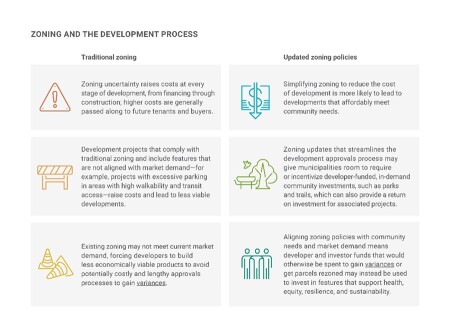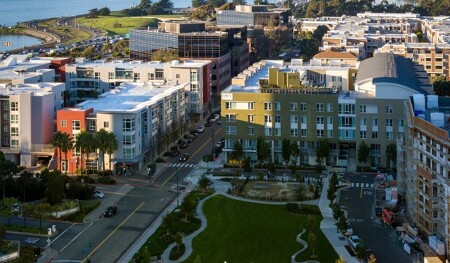Cities and towns across the United States face multiple intersecting challenges, including skyrocketing home prices, housing segregation, the need to address the legacy of racist land use regulations, and mitigating and adapting to the effects of climate change.
At the same time, many communities are working to meet the growing demand for features like trails, access to fresh food, and high-quality open spaces. For example, according to the National Recreation and Park Association, as of 2022, 85 percent of U.S. residents identified proximity to parks, playgrounds, open space, or recreation centers as an important factor in deciding where to live.
Among the most central considerations in addressing these challenges—and meeting the demand for more livable places—is zoning.
As they stand today, many zoning policies can make it difficult and costly to complete development projects that would support resilience, sustainability, health, and equity goals. Updating zoning can lessen these barriers.
Because many zoning bylaws contain outdated provisions, the process of identifying and adopting zoning reforms can give community members an opportunity to share what they value in their communities through outreach processes that influence policy decision-making.
ULI’s new report Reshaping the City: Zoning Reform for Health, Sustainability, and Resilience shares promising insights and examples of zoning regulations from across the United States. The report:
- Highlights connections among traditional zoning and land use challenges that cities and towns are grappling with today;
- Makes the case for updating zoning policies to support health, social equity, and climate action and resilience—with a focus on aligning zoning with community priorities and public- and private-sector development objectives; and
- Shares promising examples of zoning policy innovations from across the United States.
Benefits of Zoning Reform
Alongside other policies like building codes, zoning updates can increase the likelihood that development will reflect locally defined priorities that address today’s pressing challenges and meet market demand.
Common health and equity goals of zoning updates include the following:
- Increasing the production of a variety of housing types, leading to increases in affordable and attainable housing;
- Lowering the cost of housing development by reducing or eliminating policy barriers;
- Accommodating options other than driving and car ownership and a shift toward transit, biking, and walking by supporting the development of compact, mixed-use communities;
- Integrating transit and real estate development, and building more housing within walking distance of major transit hubs;
- Providing parks and open space and viewing them as critical infrastructure;
- Creating walking and biking connections to transit;
- Adding community facilities and promoting community-serving retail; and
- Including food retailers, community gardens, and farms with fresh produce in development projects.
Common goals of zoning updates related to climate resilience and low-carbon buildings include the following:
- Promoting low-carbon building principles and certification standards, such as Leadership in Energy and Environmental Design (LEED), Building Research Establishment Environmental Assessment Method (BREEAM), Passive House, and others;
- Incentivizing development in areas at comparatively low risk of climate impacts, creating a passive mechanism for extending the useful life of structures;
- Increasing pervious surfaces and open space to reduce flooding and provide important amenities to communities;
- Adding shade and reflective surfaces to mitigate the urban heat island effect, thereby enhancing community health and well-being;
- Prioritizing tree preservation and protection; and
- Supporting water conservation.
Zoning Reform: Challenging but Necessary
Updating zoning to create equitable access to community features, including sustainable buildings, clean air and water, and parks and trails, is no simple task; it requires generating consensus among stakeholders with varying needs and opinions.
Working to dismantle zoning policies that perpetuate segregation based on race and income can be particularly fraught, given how entrenched such policies are across the United States and because levels of government have systematically imposed residential segregation for over a century, including through racial zoning and redlining. (Resources, including The Color of Law by Richard Rothstein and Arbitrary Lines by Nolan Gray, provide important information on the history of racism and zoning.)
The nature of proposed solutions to create more equitable cities may be perceived as unwelcome changes to “neighborhood character.” The inequitable, unhealthy, and racist land use patterns that many zoning policies uphold are often taken as a fact of life rather than as a predictable (and often intended) product of explicitly exclusionary policy.
To produce meaningful zoning updates, multiple stakeholders need to work together—including city leaders, community members and groups, real estate developers, and nonprofit organizations. Addressing the long history of harm in communities is often difficult and emotional, and cross-sector collaboration can be challenging because it concerns people’s homes, property values, community features, and economic opportunities.
Yet, with patience and strategic outreach by city leaders that includes collaboration with trusted community institutions, small businesses, and residents, zoning update processes can lead to actionable policies that advance locally defined priorities, promote real estate success, and support the creation of places where all can thrive well into the future.
How Zoning Reform Can Streamline the Development Process
Real estate developers are essential constituents and partners in efforts to enact zoning reform. Some experienced, well-resourced developers may be adept at navigating complex local bureaucracies and may see zoning regulations as fixed frameworks. But zoning reform can make development easier and can broaden the spectrum of those who can participate in the development market, such as small-scale developers and people from underserved communities.
Advancing zoning reform can create more flexibility in the development process, potentially making projects less expensive and risky. Outdated zoning policies can make projects that aim to support in-demand types of development illegal or difficult, time intensive, and costly to complete. Outdated zoning may make projects riskier for developers and investors, may lead to expensive legal bills, and may even stall or end projects.
In contrast, zoning that advances local priorities and responds to market demand for healthier and more environmentally friendly projects allows more projects to be approved by right, making development application outcomes more certain.
Approaches and Provisions
Certain instruments and provisions are increasingly being used to advance zoning reform with the potential to promote a healthier, greener, more equitable, and resilient future. When aligned with complementary city policies and programs—including building and energy codes—zoning reforms can promote public- and private-sector investment that advances key goals.
To achieve this goal, zoning policies across the country may undergo comprehensive overhauls through processes that include extensive outreach. Public officials may also take more targeted approaches, such as providing incentives for land uses that are likely to support locally defined goals, creation of overlay zones—special districts placed over existing zones—or including provisions in addition to those already present in zoning policies. Form-based codes, which are land development regulations that use physical form (rather than separation of uses) as the organizing principle for the code, are another approach certain cities are using to support their land use goals.
For example, in 2017, Buffalo completed a comprehensive overhaul of its Unified Development Ordinance (UDO) to promote walkability and promote green and smart growth principles. As part of the update, Buffalo became the first major U.S. city to eliminate minimum parking requirements citywide. The UDO update, known as the Buffalo Green Code, was a nearly seven-year effort to overhaul the city’s zoning that included participation from thousands of community members across the city.
In 2021, Indianapolis created a zoning overlay to make developing higher-density projects near transit more straightforward. The overlay includes new design standards to ensure that developments are pedestrian-oriented. Overlay districts can also be applied to protect vulnerable communities from potential climate-related impacts, including fire, flood, and storm damage. Among the numerous examples of U.S. communities that have adopted overlay districts to protect properties from flood damage are Boston, through its Coastal Flood Resilience Overlay District, and Fairfax County, Virginia, through its Water Supply Protection Overlay District.
Zoning incentives can make certain public benefits more attractive or financially feasible for developers. Arlington County, Virginia, uses incentives to move toward its 2050 carbon neutrality goal. A major tool that has helped advance building sustainability has been the Green Building Density Incentive Program, which has gone through multiple iterations since its inception in 1999. As of 2022, Arlington allows increased floor/area ratios for development projects that achieve LEED Gold building certification and meet specified energy optimization criteria, among other provisions.
The techniques many cities are using to update zoning are familiar, but they are being employed in innovative ways. By taking an integrated, collaborative approach to sustainability, resilience, health, social equity, and housing attainability, municipalities can use zoning to set the stage for accelerated public- and private-sector investment in development projects that advance essential community objectives.
More Resources:








